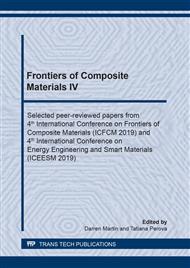[1]
Efrima, S. and H. Metiu: The Journal of Chemical Physics, 1979. 70(4): pp.1602-1613.
Google Scholar
[2]
Aravind, P. and H. Metiu:Chemical Physics Letters, 1980. 74(2): pp.301-305.
Google Scholar
[3]
Gersten, J. and A. Nitzan: The Journal of Chemical Physics, 1980. 73(7): pp.3023-3037.
Google Scholar
[4]
Wang, D.-S., H. Chew, and M. Kerker: Applied optics, 1980. 19(14): pp.2256-2257.
Google Scholar
[5]
Mirkin, C. and M. Ratner: Annu Rev Phys Chem, 1997. 101: p.1593.
Google Scholar
[6]
Rampi, M.A., O.J. Schueller, and G.M. Whitesides: Applied Physics Letters, 1998. 72(14): pp.1781-1783.
Google Scholar
[7]
Orendorff, C.J., T.K. Sau, and C.J. Murphy:Small, 2006. 2(5): pp.636-639.
Google Scholar
[8]
Scaffardi, L., et al.: Nanotechnology, 2004. 16(1): p.158.
Google Scholar
[9]
Haiss, W., et al.: Analytical chemistry, 2007. 79(11): pp.4215-4221.
Google Scholar
[10]
Ahmed, H., J. Doran, and S. McCormack: Solar Energy, 2016. 126: pp.146-155.
Google Scholar
[11]
Amendola, V., et al.: Journal of Physics: Condensed Matter, 2017. 29(20): p.203002.
Google Scholar
[12]
Myroshnychenko, V., et al.: Chemical Society Reviews, 2008. 37(9): pp.1792-1805.
Google Scholar
[13]
Alvarez, M.M., et al.: Journal of Physical Chemistry B, 1997. 101(19): pp.3706-3712.
Google Scholar
[14]
Lyon, L.A., D.J. Pena, and M.J. Natan: The Journal of Physical Chemistry B, 1999. 103(28): pp.5826-5831.
Google Scholar
[15]
Link, S. and M.A. El-Sayed, Spectral properties and relaxation dynamics of surface plasmon electronic oscillations in gold and silver nanodots and nanorods. 1999, ACS Publications.
DOI: 10.1021/jp9917648
Google Scholar
[16]
Collin, R., Field Theory of Guided Waves 2nd edn (Piscataway, NJ: IEEE). (1990).
Google Scholar
[17]
Ritchie, R.: Physical Review, 1957. 106(5): p.874.
Google Scholar
[18]
Raether, H.: Springer tracts in modern physics. Vol. 111. 1988: Springer-Verlag.
Google Scholar
[19]
Barnes, W.L., A. Dereux, and T.W. Ebbesen: Nature, 2003. 424(6950): pp.824-830.
DOI: 10.1038/nature01937
Google Scholar
[20]
Moskovits, M.: Reviews of modern physics, 1985. 57(3): p.783.
Google Scholar
[21]
Metiu, H. and P. Das: Annual Review of Physical Chemistry, 1984. 35(1): pp.507-536.
Google Scholar
[22]
Yee, K.: IEEE Transactions on antennas and propagation, 1966. 14(3): pp.302-307.
Google Scholar
[23]
Taflove, A.: IEEE Transactions on Electromagnetic Compatibility, 1980(3): pp.191-202.
Google Scholar
[24]
Ghosh, S.K. and T. Pal: Chemical reviews, 2007. 107(11): pp.4797-4862.
Google Scholar
[25]
Vial, A., et al.: Physical Review B, 2005. 71(8): p.085416.
Google Scholar
[26]
Grand, J., et al.:Plasmonics, 2006. 1(2-4): pp.135-140.
Google Scholar
[27]
Linden, S., J. Kuhl, and H. Giessen: Physical review letters, 2001. 86(20): p.4688.
Google Scholar
[28]
Maier, S.A., Plasmonics: fundamentals and applications. 2007: Springer Science & Business Media.
Google Scholar
[29]
Johnson, P.B. and R.-W. Christy: Physical review B, 1972. 6(12): p.4370.
Google Scholar
[30]
Rakić, A.D., et al.: Applied optics, 1998. 37(22): pp.5271-5283.
Google Scholar
[31]
Schneider, J.B., Understanding the finite-difference time-domain method. School of electrical engineering and computer science Washington State University.–URL: http://www. Eecs. Wsu. Edu/~ schneidj/ufdtd/(request data: 29.11. 2012), (2010).
Google Scholar


